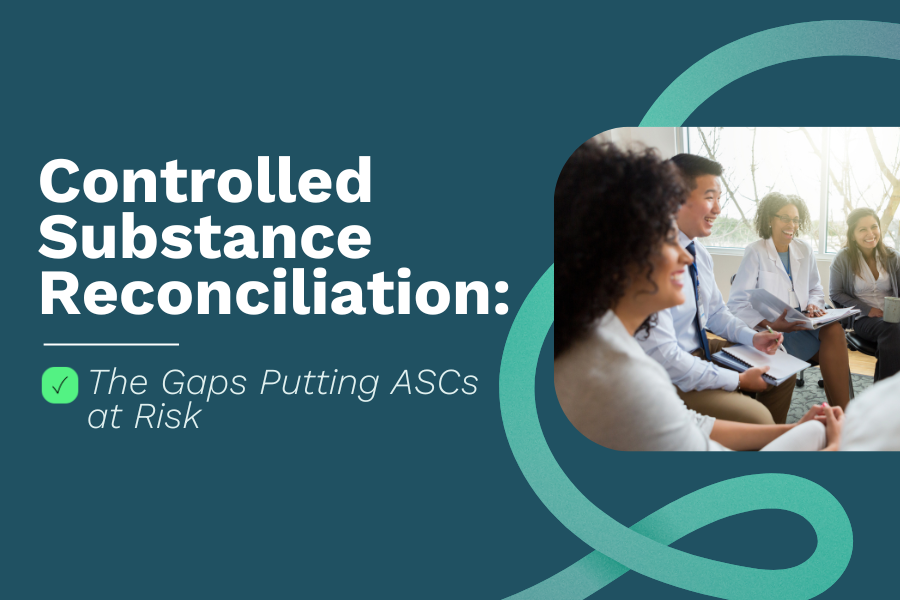Controlled Substance Reconciliation: The Gaps Putting ASCs at Risk
In today’s demanding ambulatory surgery center environment, controlled substance management remains one of the most challenging compliance areas. Despite best intentions, many ASCs struggle with proper reconciliation processes, putting patients, staff, and facilities at risk. With regulatory oversight increasing and the opioid crisis continuing to impact healthcare nationwide, addressing these reconciliation failures has never been more urgent.
The Reconciliation Reality Gap
ASCs serve an essential role in healthcare by providing high-quality, affordable surgical services. Nearly every ASC uses controlled substances for pain management and anesthesia. Unfortunately, these powerful medications carry a high risk of misuse or even theft by patients or staff.
The most common reconciliation failures we're seeing include:
Incomplete Documentation: Many ASCs maintain medication records with significant discrepancies between documented drug administration and actual usage. When records don't match reality, diversion becomes easier to conceal.
Process Inconsistencies: Different staff members often follow different procedures, creating dangerous gaps in the chain of custody for controlled substances.
Inadequate Technology Integration: While electronic health records have advanced significantly, many ASCs still rely on paper-based controlled substance tracking or disconnected systems that don't communicate effectively.
Verification Shortcuts: In busy surgical environments, staff may take shortcuts in the verification process, such as pre-signing for medications or failing to properly document waste.
Insufficient Reconciliation Frequency: Many ASCs only reconcile controlled substances at shift changes rather than after each procedure, creating windows of opportunity for diversion.
The High Stakes of Reconciliation Failures
Diversion of controlled substances is not uncommon and creates substantial risk not only to the individual diverting the drugs but also to patients, co-workers, and employers. The consequences of poor reconciliation practices extend far beyond regulatory compliance:
Patient Safety Risks: When medications are diverted, patients may receive inadequate pain management or anesthesia.
Staff Health Concerns: Diversion often indicates substance abuse disorders among healthcare professionals, putting their health and careers at risk.
Regulatory Penalties: Failure to comply with DEA regulations and accreditation requirements may result in severe consequences, including fines, loss of DEA registration, and potential legal ramifications.
Reputational Damage: News of diversion incidents can severely damage an ASC's reputation in the community.
Building Better Reconciliation Systems
Effective controlled substance reconciliation requires a systematic approach:
Standardize Procedures: Develop clear, consistent reconciliation protocols that all staff must follow, regardless of role or shift. Create step-by-step workflows that remove any confusion about responsibility and timing.
Increase Accountability: Implement a system of checks and balances where multiple staff members verify counts and waste. Consider implementing a witness requirement for all waste procedures and count verifications.
Leverage Technology: Invest in integrated medication management systems that track controlled substances from delivery to administration to waste. Automated dispensing cabinets with biometric access can significantly reduce diversion risk while improving reconciliation accuracy.
Staff Education: Regular training on proper reconciliation procedures and signs of diversion helps create a culture of awareness and accountability. This education should include not just procedural training but also awareness of the warning signs that a colleague might be diverting medications.
Regular Audits: Conduct surprise audits of controlled substance inventory and documentation to identify discrepancies quickly. These audits should occur at random intervals across all shifts to ensure comprehensive oversight.
Establish Clear Discrepancy Protocols: Develop a standardized process for investigating and resolving discrepancies when they occur, with clear escalation pathways and documentation requirements.
Real-World Implementation Strategies
Putting these reconciliation principles into practice requires thoughtful implementation. Consider these practical approaches:
Start With a Gap Analysis: Before making changes, assess your current reconciliation process to identify specific weaknesses. This might involve reviewing documentation, observing workflows, and speaking with staff about challenges.
Prioritize High-Risk Areas: Focus initial improvement efforts on areas with the highest risk of diversion, such as anesthesia medications and opioid pain management drugs.
Set Clear Metrics: Establish key performance indicators for your reconciliation process, such as percentage of perfect reconciliations, time to resolve discrepancies, and number of unexplained losses.
Phased Implementation: Rather than overhauling your entire system at once, consider implementing changes in phases to allow staff to adjust and provide feedback.
Moving Forward
As regulations tighten and the opioid crisis continues, ASCs must strengthen their controlled substance reconciliation practices. This isn't just about compliance—it's about patient safety, staff wellbeing, and organizational integrity.
The ASCs leading the way are those treating reconciliation as a critical clinical process rather than just another documentation requirement. By putting strong systems in place, using the right technology, and building a culture of accountability, ASCs can close the reconciliation gaps that put everyone at risk.
Remember that effective controlled substance reconciliation is a continuous journey, not a destination. Regular review and refinement of your processes will ensure they remain effective as your facility, staff, and regulatory environment evolve.
Ready to strengthen your ASC’s reconciliation process?
Schedule a quick call to see how MedServe helps facilities close gaps, improve safety, and stay compliant.

